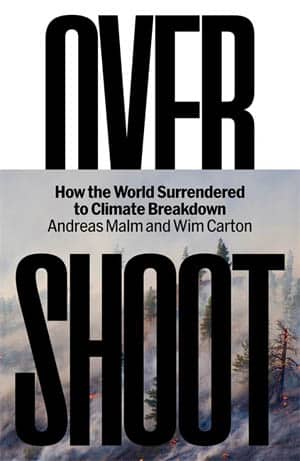
“As a consequence of ever-delayed emission reductions, there is a high chance of exceeding global warming of 1.5 °C, and even 2 °C, under emission pathways reflecting current policy ambitions1. Even if global temperatures are brought down below those levels in the long term, such an overshoot will come with irreversible consequences. Only stringent, immediate emission reductions can effectively limit climate risks.” —Nature, October 9, 2024
HOW MAINSTREAM CLIMATE SCIENCE ENDORSED
THE FANTASY OF A GLOBAL WARMING TIME MACHINE
by Wim Carton and Andreas Malm
When the Paris agreement on climate change was gaveled into being in December 2015, it briefly looked like that rarest of things: a political victory for climate activists and delegates from the poorest regions of the world that, due to colonization by today’s wealthy nations, have contributed little to the climate crisis—but stand to suffer its worst ravages.
The world had finally agreed an upper limit for global warming. And in a move that stunned most experts, it had embraced the stretch target of 1.5°C, the boundary that small island states, acutely threatened by sea-level rise, had tirelessly pushed for years.
Or so, at least, it seemed. For soon, the ambitious Paris agreement limit turned out to be not much of a limit at all. When the Intergovernmental Panel on Climate Change (or IPCC, the world’s foremost body of climate experts) lent its authority to the 1.5°C temperature target with its 2018 special report, something odd transpired.
Nearly all modeled pathways for limiting global heating to 1.5°C above pre-industrial levels involved temporarily transgressing this target. Each still arrived back at 1.5°C eventually (the deadline being the random end point of 2100), but not before first shooting past it.
Scientists responsible for modeling the response of Earth’s climate to greenhouse gas emissions—primarily caused by burning fossil fuels—called these “overshoot” scenarios. They became the dominant path along which mitigating climate change was imagined to proceed, almost as soon as talk of temperature limits emerged.
De facto, what they said was this: staying below a temperature limit is the same as first crossing it and then, a few decades hence, using methods of removing carbon from the atmosphere to dial temperatures back down again.
From some corners of the scientific literature came the assertion that this was nothing more than fantasy. A new study published in Nature has now confirmed this critique. It found that humanity’s ability to restore Earth’s temperature below 1.5°C of warming, after overshooting it, cannot be guaranteed. Many impacts of climate change are essentially irreversible. Those that are might take decades to undo, well beyond the relevant horizon for climate politics. For policy makers of the future, it matters little that temperatures might eventually fall back again; the impacts they will need to plan for are those of the overshoot period itself.
The rise of overshoot ideology
Even if global average surface temperatures are ultimately reversed, climate conditions at regional levels might not necessarily follow the global trend and might end up different from before. Delayed changes in ocean currents, for instance, could mean that the North Atlantic or Southern Ocean continue warming while the rest of the planet does not.
Any losses and damages that accumulate during the overshoot period itself would of course be permanent. For a farmer in Sudan whose livestock perishes in a heat wave that would have been avoided at 1.5°C, it will be scant consolation to know that temperatures are scheduled to return to that level when her children have grown up.
Then there is the dubious feasibility of planetary-scale carbon removal. Planting enough trees or energy crops to make a dent in global temperatures would require whole continents of land. Direct air capture of gigatonnes of carbon would consume prodigious amounts of renewable energy and so compete with decarbonization. Whose land are we going to use for this? Who will shoulder the burdens for all this excess energy use?

Our own book on this topic (Overshoot: How the World Surrendered to Climate Breakdown, published last week by Verso) offers a history and critique of the idea.
When overshoot scenarios were summoned into being in the early 2000s, the single most important reason was economics. Rapid, near-term emissions cuts were deemed prohibitively costly and so unpalatable. Cost optimization mandated that they be pushed into the future to the extent possible.
The models for projecting possible mitigation trajectories had these principles written into their code and so for the most part could not compute “low” temperature targets like 1.5 or 2°C. And because modelers could not imagine transgressing the deeply conservative constraints that they worked within, something else had to be transgressed.
One team stumbled upon the idea that large-scale removal of carbon might be possible in the future, and so help reverse climate change. The EU and then the IPCC picked up on it, and before long, overshoot scenarios had colonized the expert literature. Deference to mainstream economics yielded a defense of the political status quo. This in turn translated into reckless experimentation with the climate system. Conservatism or fatalism about society’s capacity for change flipped into extreme adventurism about nature.
Time to bury the time machine
Just as the climate movement scored an important political victory, compelling the world to rally behind an ambitious temperature limit, an influential group of scientists, amplified by the world’s most authoritative scientific body on the subject, effectively helped water it down. When all is said and written about the post-Paris era, this surely should stand as one of its greatest tragedies.
By conjuring up the fantasy of overshoot-and-return, scientists invented a mechanism for delaying climate action and unwittingly lent credibility to those (and they are many) who have no real interest in reigning in emissions here and now; who will seize on any excuse to keep the oil and gas and coal flowing just a little longer.
The findings of this new paper make it perfectly clear: There is no time machine waiting in the wings. Once 1.5°C lies behind us, we must consider that threshold permanently broken.
There then remains only one road to ambitious mitigation of climate change, and no amount of carbon dioxide removal can absolve us of its inconvenient political implications.
Avoiding climate breakdown demands that we bury the fantasy of overshoot-and-return and with it another illusion as well: that the Paris targets can be met without uprooting the status-quo. One limit after the other will be broken unless we manage to strand fossil fuel assets and curtail opportunities for continuing to profit from oil and gas and coal.
We will not mitigate climate change without confronting and defeating fossil fuel interests. We should expect climate scientists to be candid about this.
This article is republished from The Conversation under a Creative Commons license. Read the original article.



Yes, by all means, overshoot must be avoided as much as possible, Therefore the climate protection agenda must include a fierce struggle to avoid every 0.01, 0.1°C of additional warming over the 1.5°C target, as the climate scientist Richard Betts recognized (https://climateandcapitalism.com/2024/01/08/an-ecosocialist-strategy-that-can-still-make-1-5-possible/). How much above this warming target and for how long it persists will determine the likelihood of emergence of dangerous tipping points in the climate system. Since there is uncertainty in predicting just when these tipping points kick in, the precautionary principle strongly supports no overshoot as Carton and Malm argue (on the issue of uncertainty see Ben-Yami et al., 2024 and https://global-tipping-points.org). Carton and Malm say “there is the dubious feasibility of planetary-scale carbon removal.” However, planetary-scale carbon removal from the atmosphere will be needed to bring down the atmospheric level of carbon dioxide below 350 ppm and keep it there, but ONLY after there is a global commitment for a program for complete termination of fossil fuel combustion and ONLY when enough renewable energy capacity is in place to drive this removal. A promising site for this drawdown is in Oman where highly reactive ultramafic rocks are outcropping, see our paper at:
http://www.aimspress.com/article/doi/10.3934/energy.2024038.
Reference cited:
Ben-Yami et al., 2024 Uncertainties too large to predict tipping times of major Earth system components from historical data. Sci. Adv. 10, eadl4841, DOI: 10.1126/sciadv.adl4841.